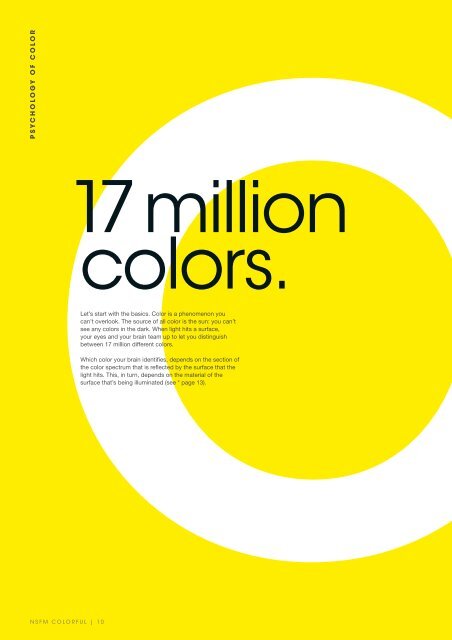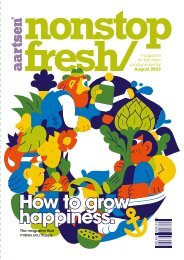19040_NSFM-jan 2022_colorful_Compleet Spreads_LR
Create successful ePaper yourself
Turn your PDF publications into a flip-book with our unique Google optimized e-Paper software.
PSYCHOLOGY OF COLOR<br />
10OL<br />
Experiencing color<br />
17 million<br />
This all sounds a bit technical. Let’s make things more<br />
concrete by talking about how we experience color.<br />
On the one hand, things like personal interpretation,<br />
culture and context play an important role in determining<br />
which associations a color evokes. On the other hand,<br />
we also have shared experiences. We know this is the case,<br />
because marketing experts and designers consciously<br />
choose certain colors for certain moments.<br />
colors.<br />
After all, they know just how consumers respond or what<br />
feelings a certain color induces. Red, for instance, is a color<br />
that catches your eye and is ideal for quickly attracting<br />
attention. Green stands for life, growth and nature and<br />
creates a sense of calm in many people. Pink can have<br />
a calming effect as well. Orange is associated with fun,<br />
optimism and happiness. Blue radiates reliability and safety,<br />
but also distance. Purple represents style, luxury and riches.<br />
Grey doesn’t really express much. Black is both fashionable<br />
Let’s start with the basics. Color is a phenomenon you<br />
and inaccessible and is associated with both glamour and<br />
can’t overlook. The source of all color is the sun: you can’t<br />
fear, mourning and being cool.<br />
see any colors in the dark. When light hits a surface,<br />
your eyes and your brain team up to let you distinguish<br />
between 17 million different colors.<br />
In nature<br />
Which color your brain identifies, depends on the section of<br />
the color spectrum that is reflected by the surface that the<br />
So these are the general impressions and meanings of color.<br />
light hits. This, in turn, depends on the material of the<br />
This raises the following question: what role does color<br />
surface that’s being illuminated (see * page 13).<br />
play in nature? Nature always prefers function over form.<br />
Generally speaking, it means that plants and animals have<br />
either a striking color or a protective color.<br />
A protective or concealing color ensures that a plant or<br />
animal is not noticed by enemies. A bright color warns<br />
that the species might be poisonous or helps to attract the<br />
opposite sex. Many male animals are extra good-looking<br />
and <strong>colorful</strong> in order to attract females.<br />
Colorful plants attract insects and other animals. If the<br />
berries of a plant need to be spread around by animals for<br />
the purpose of reproduction, then it makes sense for the<br />
berries to be visually striking, so that insects or birds can<br />
find them more easily. Red berries among green leaves have<br />
this effect.<br />
<strong>NSFM</strong> COLORFUL | <strong>NSFM</strong> COLORFUL | 11

















